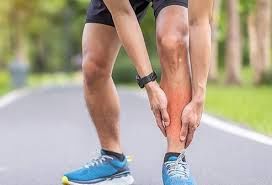What are shin splints?
Shin splints describes pain felt along the shinbone, from the knee to ankle. The pain is caused by inflammation of the muscles, tendons and bone around the front of the lower leg.
Shin splints, or "medial tibial stress syndrome" is common in runners, sports people and dancers and occur due to training errors - for example, running too fast or training too much, too quickly.
It is a stress injury which caused by repetitive overload or strain of the muscles and tendons that attach to the leg bone (tibia).
What are the symptoms of shin splints?
Pain normally occurs at the bottom third of the leg, but can vary depending on the grade of the injury and other factors. Normally pain is localised to the shin, dull but can be sharp at times. People can feel pain at the beginning of exercise, and the pain might "warm up" or disappear completely. However, people might notice stiffness or soreness after they stop, and may be limping. The pain can linger and be there at rest.
When left untreated or unmanaged, shin splints can worsen, leading to stress fractures of the tibia.This happens because the repetitive traction or "pulling" of the muscle on the bone is so stressful that it causes the bone to crack. This presents itself as tenderness along the shin, with or without pain at night and stiffness in the morning. Stress fractures should be taken as seriously as other fractures of the bone, though their management might differ slightly.
What causes shin splints?
Aside from training errors, other reasons why people develop shin splints include:
- Foot posture (e.g. flat feet or high arches)
- Tightness and weakness of the calf muscles
- Change in running surface including slope, terrain, or repetitive road running
- Using new footwear
- Reduced bone density (e.g. osteoporosis)
- Previous history of stress injuries
How are shin splints diagnosed?
Early diagnosis is key, and shin splints can be diagnosed by your physiotherapist during a consultation. The sooner you manage your stress injury, the quicker you might be able to recover and prevent further injury. Your physiotherapist might recommend imaging (e.g. an MRI) to help diagnose a stress fracture which might not be detected on general x-ray. It is important to diagnose shin splints correctly as there are a number of lower leg injuries that can be very serious or need emergency care.
How are shin splints treated?
Once shin splints are diagnosed, it is important to manage the acute symptoms related to the injury. This includes RICE protocol, and if your injury involves a lot of inflammation, sometimes medication can be helpful. It is important to modify your load to avoid further deterioration of the muscle injury or the bone injury. Your physiotherapist will help guide you through strengthening and stretching exercises to best promote healing and optimise your biomechanics. Other treatment options include shockwave therapy and dry needling. Other things you can do include cross training, changing running surface (softer, level ground) or changing the type of running (e.g. treadmill running, backwards running).
When returning to exercise, seek the guidance of your physiotherapist, who can provide a running program or loading program that will be safe for your muscle and bone recovery. Remember, the biggest risk factor for an injury is a history of a previous one. We cannot "stress" this enough for a shin splints injury and it is more than likely to occur again if not addressed.
What if I have a stress fracture?
Most stress fractures can be managed conservatively and most people will make a full recovery with the guidance of their physiotherapist or sports doctor. Normally surgery is not indicated, but it will always depend on the position of the fracture, involvement of the joints and the goals of the person. Most stress fractures of the tibia require time off legs and involve immobilisation over a period of time (e.g. Moonboot).

